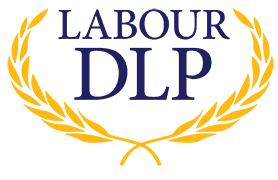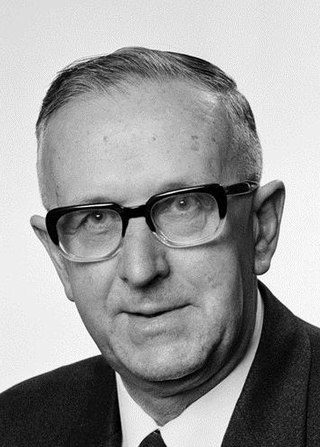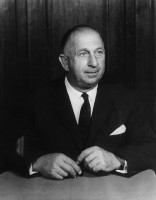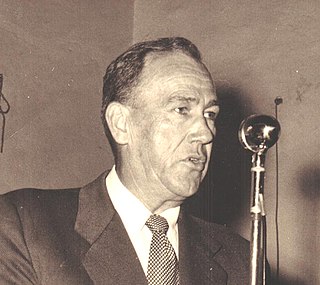Related Research Articles

Vincent Clair Gair was an Australian politician. He served as Premier of Queensland from 1952 until 1957, when his stormy relations with the trade union movement saw him expelled from the Labor Party. He was elected to the Australian Senate and led the Democratic Labor Party from 1965 to 1973. In 1974 he was appointed Australian Ambassador to Ireland by the Whitlam government, which caused his expulsion from the DLP.

The Democratic Labour Party (DLP), formerly the Democratic Labor Party, is an Australian political party. It broke off from the Australian Labor Party (ALP) as a result of the 1955 ALP split, originally under the name Australian Labor Party (Anti-Communist), and was renamed the Democratic Labor Party in 1957. In 1962, the Queensland Labor Party, a breakaway party of the Queensland branch of the Australian Labor Party, became the Queensland branch of the DLP.

Bartholomew Augustine Santamaria, usually known as B. A. Santamaria, or Bob Santamaria, was an Australian Roman Catholic anti-communist political activist and journalist. He was a guiding influence in the founding of the Democratic Labor Party (DLP), the party that split from the Labor Party (ALP) in the 1950s.
The Labor Left, also known as the Progressive Left or Socialist Left, is a political faction of the Australian Labor Party (ALP). It competes with the more economically liberal Labor Right faction.

Daniel Patrick Mannix was an Irish-born Catholic bishop. Mannix was the Archbishop of Melbourne for 46 years and one of the most influential public figures in 20th-century Australia.

John Cain was an Australian politician, who became the 34th premier of Victoria, and was the first Labor Party leader to win a majority in the Victorian Legislative Assembly. He is the only premier of Victoria to date whose son has also served as premier.

John William Austin was an Australian rules football player for the South Melbourne Swans from 1930 to 1938, playing 140 games in the back-pocket and at full-back. Austin was judged one of the best players in South Melbourne's 1933 premiership win over the Richmond Football Club.

Francis Patrick Vincent McManus, Australian politician, was the last leader of the parliamentary Democratic Labor Party and a prominent figure in Australian politics for 30 years.
John Patrick Ducker AO, Australian labour leader and politician, played a leading role in the Australian labour movement and the Labor Party for 20 years.
The National Civic Council (NCC) is a conservative Christian lobby group in Australia, founded by B. A. Santamaria in the 1940s. The NCC publishes a weekly magazine, News Weekly.

Standish Michael Keon was an Australian politician who represented the Australian Labor Party in the Federal Parliament from 1949 to 1955, having served previously in the State Parliament of Victoria.
Patrick Leslie Coleman, Australian politician, was a member of the Victorian Legislative Council for Melbourne West Province representing the Labor Party from October 1943 until March 1955. He was a member of the Catholic Social Studies Movement in Victoria, and was expelled from the ministry and the ALP as part of the Australian Labor Party split of 1955. After his expulsion from the ALP in March 1955, he became, with Bill Barry in the Victorian Legislative Assembly, the parliamentary leader of the Australian Labor Party (Anti-Communist), which was briefly referred to in the media as the Coleman-Barry Labor Party. He was a member of that party only until June 1955.
William Peter Barry was a Member of the Victorian Legislative Assembly for the Electoral district of Carlton from July 1932 until April 1955. Barry was a member of the Labor Party until March 1955, when he was expelled from the party as part of the Australian Labor Party split of 1955. He became, with Les Coleman in the Victorian Legislative Council, joint leader of the Australian Labor Party (Anti-Communist), a party that in 1957 became the Democratic Labor Party.
The Australian Labor Party split of 1955 was a split within the Australian Labor Party along ethnocultural lines and about the position towards communism. Key players in the split were the federal opposition leader H. V. "Doc" Evatt and B. A. Santamaria, the dominant force behind the "Catholic Social Studies Movement" or "the Movement".

The 1955 Victorian state election was held in the Australian State of Victoria on Saturday, 28 May 1955 to elect 65 members of the state's Legislative Assembly.
Socialism in Australia dates back at least as far as the late-19th century. Notions of socialism in Australia have taken many different forms including utopian nationalism in the style of Edward Bellamy, the democratic socialist reformist electoral project of the early Australian Labor Party (ALP), and the revolutionary Marxism of parties such as the Communist Party of Australia.

Tom Nicholson Pearce Dougherty, was an Australian trade union official and a member of the New South Wales Legislative Council. As National Secretary of the Australian Workers Union (AWU) from 1944 to 1972, he was one of the most powerful figures in the Australian labor movement and the Labor Party.
The history of the Australian Labor Party has its origins in the Labour parties founded in the 1890s in the Australian colonies prior to federation. Labor tradition ascribes the founding of Queensland Labour to a meeting of striking pastoral workers under a ghost gum tree in Barcaldine, Queensland in 1891. The Balmain, New South Wales branch of the party claims to be the oldest in Australia. Labour as a parliamentary party dates from 1891 in New South Wales and South Australia, 1893 in Queensland, and later in the other colonies.
The Federated Clerks Union of Australia (FCU) was an Australian trade union representing clerical workers, in existence from 1911 to 1993, when it amalgamated with the Australian Services Union.
The Victorian Labor Party, officially known as the Australian Labor Party (Victorian Branch) and commonly referred to simply as Victorian Labor, is the Victorian state branch of the Australian Labor Party (ALP). The branch is currently the ruling parting in the state of Victoria and is led by Jacinta Allan, who has served concurrently as premier of Victoria since 2023.
References
- ↑ Bruce Duncan. Crusade or Conspiracy? Catholics and the Anti-Communist Struggle in Australia (2001), University of New South Wales Press; ISBN 0-86840-731-3
- 1 2 3 Gavan Duffy (9 April 2005). "Australian history: The Labor Split – 50 years on". News Weekly . Archived from the original on 19 April 2010. Retrieved 28 October 2010.
- 1 2 "Defining Momnents : ALP Split".
- ↑ Murray, Robert (1970). "2". The Split: Australian labor in the fifties (First ed.). F. W. Cheshire. p. 13.
- ↑ Schneiders, Ben. "The great 'Shoppies' union sell out". Sydney Morning Herald. Retrieved 26 March 2020.
- ↑ "The Democratic Labor Party an overview". Parliament of Australia. Retrieved 5 March 2014.